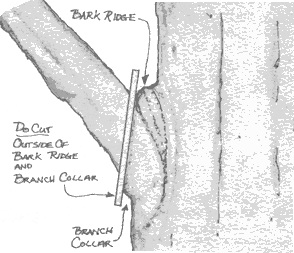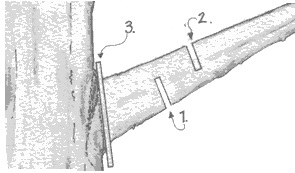 Pruning Sealants Can Inhibit Healing - November 10, 2010 Jeff Schalau, Associate Agent, Agriculture & Natural Resources University of Arizona Cooperative Extension, Yavapai County Pruning woody ornamental plants is both an art and a science. Pruning live material from a woody plant always reduces its photosynthetic area and creates a wound which will require energy and resources to heal. In contrast, there are situations where pruning becomes necessary to promote a tree’s health, reduce hazards to people and property, and train a young tree shortly after planting. Pruning cuts also create potential entry points for insect and disease organisms. Many people feel the need to apply wound dressings or tree sealants following pruning. However, the use of these sealants is not based on science and has been shown time and again to inhibit the healing of pruning wounds. Many pruning sealant products are petroleum-based and make claims such as “designed to aid healing of pruning cuts, grafts, abrasions, and wounds on woody plants and trees.” One product also claims that it “can also be used to seal and waterproof clay and wood planting pots and tubs, gutters, flashings, and small patches on asphalt driveways and walkways.” Other products may be formulated with natural ingredients such as collagen, pectin, hydrogel, and aloe gel and labeled as “natural” tree healers. While I cannot address their non-horticultural claims, the horticultural benefit of applying any of these products to pruning wounds is not supported by scientific research. Woody plants are already well equipped to stave off most insects and diseases using their own natural defenses. First, gardeners should understand that trees do not heal. Instead, they isolate damage through formation of suberized, lignified wood that physically and chemically repels colonization by harmful organisms. This process is called compartmentalization. After pruning, callus tissue develops at the edge of the wound and gradually expands towards the center. On healthy plants that are pruned correctly, new wood eventually covers the wound and evidence of wounding/healing is covered over by subsequent growth. Well placed pruning cuts are made to maximize the tree’s natural ability to close its wound and defend itself from infection. Sharp, clean pruning tools will also help alleviate pruning-related disease problems. When pruning, make clean, smooth cuts. Do not leave branch stubs. Leave a small collar of wood at the base of the branch. The branch collar is a slightly swollen area where the branch attaches to the trunk. Cutting the limb flush with the trunk will leave a larger area to callus over and a greater chance of decay organisms entering the wound. Use the “three-cut” method to remove larger branches. Start by making a slight undercut well above the location of the final cut. The second cut should be on the top of the branch above the undercut. This cut removes the weight of the branch and prevents bark stripping. The final cut should be made outside the branch collar. I have included a graphic of this procedure below. If pruning is done during the dormant season, the chance of infection is greatly reduced and wound treatment should be avoided. It is recommended that you sanitize pruning tools prior to cutting. Sanitizing can be accomplished by soaking in 70% isopropyl alcohol for 1-2 minutes. A 10% bleach solution is recommended by some, but be aware that bleach is highly corrosive and can also ruin your clothing. In summary, plants have natural resistance mechanisms to fight insect attack or disease. Pruning sealants are unnecessary and covering wounds with traditional sealants inhibits oxidative processes, which in turn will reduce callus formation and subsequent compartmentalization. The promotion of pruning sealants is simply a marketing strategy that preys on our emotions. We all want to nurture our plants and we all need to understand that woody plants have the innate ability to protect themselves. Just say “no” to pruning sealants. Follow the Backyard Gardener on Twitter – use the link on the BYG website (see link below). If you have other gardening questions, call the Master Gardener line in the Cottonwood office at 646-9113 ext. 14 or e-mail us at cottonwoodmg@yahoo.com and be sure to include your name, address and phone number. Find past Backyard Gardener columns or provide feedback at the Backyard Gardener web site: http://cals.arizona.edu/yavapai/anr/hort/byg/.   |